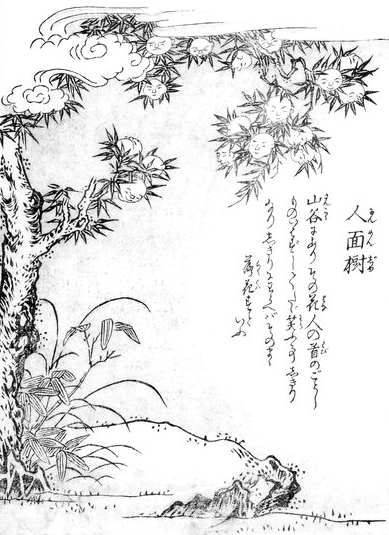Jinmenju on:
[Wikipedia]
[Google]
[Amazon]
 Jinmenju or Ninmenju () is a type of ''
Jinmenju or Ninmenju () is a type of ''
 Jinmenju or Ninmenju () is a type of ''
Jinmenju or Ninmenju () is a type of ''Yōkai
are a class of supernatural entities and Spirit (supernatural entity) , spirits in Japanese folklore. The kanji representation of the word comprises two characters that both mean "suspicious, doubtful", and while the Japanese name is simply ...
'' and ''Yaoguai
Yaoguai ( zh, 妖怪, p=yāoguài, s=妖怪, t=妖怪) represent a broad and diverse class of ambiguous creatures in Chinese folklore and Chinese mythology, mythology defined by the possession of supernatural powers and by having attributes tha ...
'' in Japanese and Chinese folklore. It is commonly depicted as a tree bearing flowers that resemble human heads. It notably appears in the Edo period
The , also known as the , is the period between 1600 or 1603 and 1868 in the history of Japan, when the country was under the rule of the Tokugawa shogunate and some 300 regional ''daimyo'', or feudal lords. Emerging from the chaos of the Sengok ...
''Konjaku Hyakki Shūi
is the third book of Japanese artist Toriyama Sekien's ''Gazu Hyakki Yagyō'' tetralogy, published c. 1781. These books are supernatural bestiaries, collections of ghosts, spirits, spooks and monsters, many of which Toriyama based on literature ...
'' by Toriyama Sekien
200px, A , specifically a Miage-nyūdō, as portrayed by Toriyama
, real name Sano Toyofusa, was a scholar, '' kyōka'' poet, and ''ukiyo-e'' artist of Japanese folklore.
Early life
Born to a family of high-ranking servants to the Tokugawa sh ...
.
Concept
The ''Konjaku Hyakki Shūi'' depicts it as a tree blooming with flowers that resemble human heads, with the following explanatory text: Besides Japaneseyōkai
are a class of supernatural entities and Spirit (supernatural entity) , spirits in Japanese folklore. The kanji representation of the word comprises two characters that both mean "suspicious, doubtful", and while the Japanese name is simply ...
, the ''Konjaku Hyakki Shūi'' also included publications of plants, animals and yōkai outside of Japan and this "jinmenju", as well as the ''Wakan Sansai Zue'', quote from the Chinese ''Sancai Tuhui
''Sancai Tuhui'' (, ), compiled by Wang Qi () and his son Wang Siyi (), is a Chinese '' leishu'' encyclopedia, completed in 1607 and published in 1609 during the late Ming dynasty, featuring illustrations of subjects in the three worlds of heave ...
'', which describes a similar tree from a land called "Dashiguo" ( romaji
The romanization of Japanese is the use of Latin script to write the Japanese language. This method of writing is sometimes referred to in Japanese as .
Japanese is normally written in a combination of logogram, logographic characters borrowe ...
: ; ).
According to the ''Sancai Tuhui'', Dashiguo is a land one thousand '' li'' southwest, with flowers like human heads, and upon asking it questions, its flowers would laugh, but it wouldn't understand human language. If they laughed too much, the flowers would wither and fall. The ''Rōō Sawa'' (), a collection of strange tales from Aizu
is the westernmost of the three regions of Fukushima Prefecture, Japan, the other two regions being Nakadōri in the central area of the prefecture and Hamadōri in the east. As of October 1, 2010, it had a population of 291,838. The princ ...
, also quotes the ''Sancai Tuhui'' while making statements about this tree.
In popular culture
ThePokémon
is a Japanese media franchise consisting of List of Pokémon video games, video games, Pokémon (TV series), animated series and List of Pokémon films, films, Pokémon Trading Card Game, a trading card game, and other related media. The fran ...
Exeggutor is based on the jinmenju.
See also
*List of tree deities
A tree deity or tree spirit is a nature deity related to a tree. Such deities are present in many cultures. They are usually represented as a young woman, often connected to ancient fertility and tree worship lore.Heinrich Zimmer, ''Myths and S ...
* Nariphon
* Wāḳwāḳ
Al-Wakwak ( '), also spelled al-Waq Waq, Wak al-Wak or just Wak Wak, is the name of an island, or possibly more than one island, in medieval Arabic geographical and imaginative literature.
Identification with civilisations
Wakwak is referre ...
Notes
External links
* (English) * (Japanese) Mythological human hybrids Trees in mythology Japanese folklore Chinese folklore Yōkai Yaoguai Mythological plants {{Japan-myth-stub